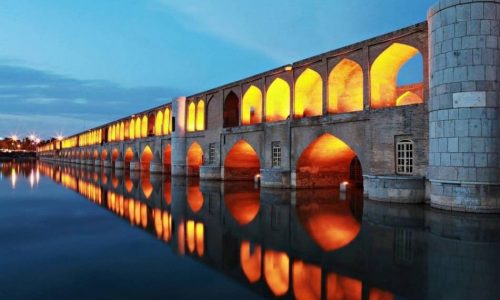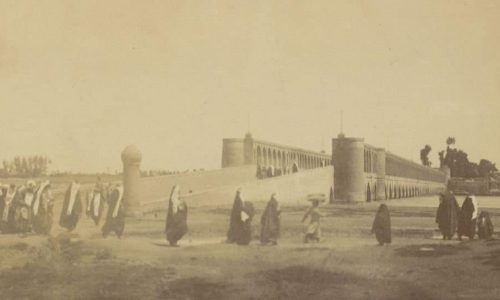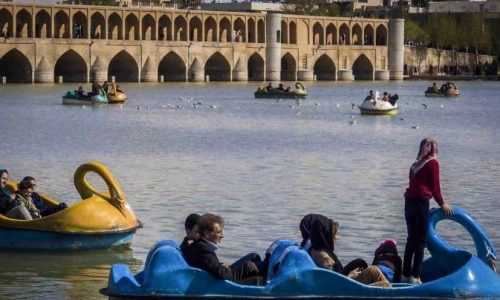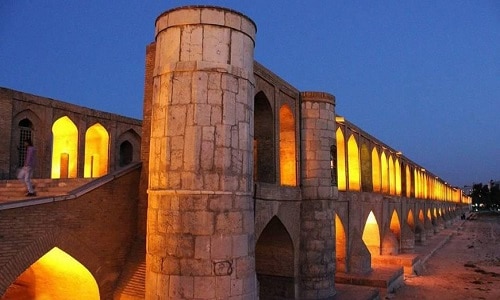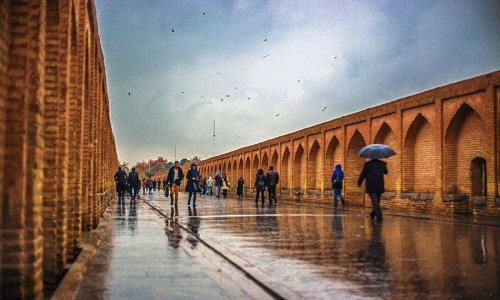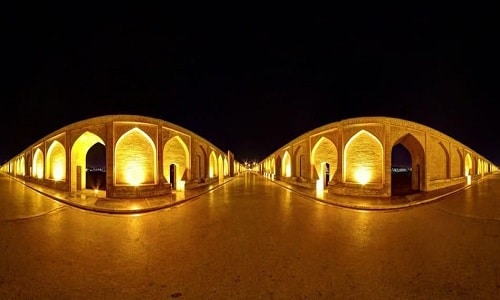One of the most famous bridges in Isfahan, whose name and reputation have spread to other countries, is Si-O-Se-Pol bridge. This bridge, as the longest bridge on the Zayandehrood River in Isfahan, was built about 400 years ago by order of Shah Abbas Safavid. The reason for naming this bridge as Si-O-Se-Pol bridge is due to the existence of 33 valves that drained the water of Zayandehrood River.
The name of this valuable work has been in the list of national monuments of Iran since December 6, 1961 with the registration number 110 and it is mentioned as one of the most popular attractions in Iran.
History of Si-O-Se-Pol Bridge
The forty-three bridge structure was built by Allahvardikhan Ondiladze Gorji, the famous commander of Shah Abbas. Some Georgians believe that because the letters of the Georgian alphabet have thirty-three letters and Allahvordikhan is of Georgian descent, this bridge also has thirty-three spans. Of course, this theory is completely rejected because at first the bridge had forty spans. On the other hand, experts consider the number one hundred and thirty-three to be related to Anahita (goddess of water) and believe that this bridge, like most water structures and bridges, is a symbol of Anahita.
In the time of Shah Abbas, the main plan of Isfahan was Chaharbagh, which consisted of two axes perpendicular to each other. Si-O-Se-Pol bridge were placed along one of these main axes to connect Chaharbagh Abbasi to Chaharbagh Bala, Hezar Jarib Garden, Abbasabad and Jolfa neighborhood. In 1330, Mostafa Khan Mostofi, the mayor of Isfahan, liberated the lands around the bridge and after opening the water passage, built a stone wall on its north side, the traces of which can still be seen.
Different sources have written different years for the construction of Si-O-Se-Pol bridge; But what is more famous is that Allah Verdikhan completed the construction of the lower floor of the bridge in 1005 AH and in 1011 he was commissioned to complete it and build the upper floor so that traffic would not be disrupted when the river overflowed. What we know today as the Si-O-Se-Pol bridge have had other names throughout history, including the Shah Abbasi Bridge, the Allah Verdikhan Bridge, the Jolfa Bridge, and the Chehel Cheshmeh Bridge.
Si-O-Se-Pol bridge a place for fun
Si-O-Se-Pol bridge are not just a monument that you sometimes visit and experience a tour of the past. This bridge still shines like a jewel on a ring in Isfahan and people value it very much. Just visit it near sunset to both enjoy walking on the bridge and watching the sunset view and share in the joy of the people who have gathered around it You can visit cafes and restaurants around the bridge and create delicious moments for yourself. The green space next to this bridge is a recreation area for the residents and guests of this city and you always see a large crowd there. Do not be surprised if you see a musician or singer next to the bridge, it is the feature of the nights of the Si-O-Se-Pol bridge that makes everyone full of feelings. Boating and sightseeing in the middle of the river is also a popular pastime for people and tourists in this area.
Si-O-Se-Pol bridge architecture
The architect of Si-O-Se-Pol bridges is Ustad Hossein Bana Isfahani, whose son Mohammad Reza Isfahani has a masterpiece such as Sheikh Lotfollah Mosque in his record. Although bridges are usually built in narrow sections, he chose the widest part of the Zayandeh River to build this bridge; Because this part of the river was created in a shallow, wide and calm bed and had a spectacular view.
Si-O-Se-Pol bridge are made of three main materials: stone for the lower parts and brick and mortar and plaster for the upper parts. Mortar is one of the initiatives of Iranian architects in ancient times, which is prepared from clay and lime, ash and fiber materials (eggs and villi of a kind of straw) and in special stages. According to geologists and cultural heritage experts, the foundation of the bridge is built in a way that moisture, increases its durability and strength, which is why water cannot damage it in the long run.
According to Sir Percy Molesworth Sykes, a British writer and geographer, about the Si-O-Se-Pol bridges and their condition at the end of the thirteenth and early fourteenth centuries AH, it is possible to enter the bridge from a paved highway. There were three crossings on three different levels in the bridge.
The pedestrian bridge has 99 niches with paintings on them and no trace of them can be seen today. The arches of the bridge have columns 7 to 9 meters high that support the roof and look very magnificent and strong. Initially, the bridge was 360 meters long and had 40 spans (large arch); But today it has 33 spans and 14 meters wide and with 295 meters length it is mentioned as the longest bridge of Zayandehrood River.
In the past, this bridge had 6 crossings, which were:
1. The middle road, which was for passing horses and carts.
2 & 3. Both sides of the bridge, which passed through beautiful galleries and was dedicated to the sidewalk.
4 & 5. The roofs of the galleries on both sides, which had fences around them and turned into a magnificent promenade when the Zayandehrood River overflowed.
6. Finally, the bridge galleries were reached under the bridge by delicate stairs, and this place was a place of passage in times of water shortage.
But today there are only two sidewalks; One at the top, the roof of which is the sky, and the other at the bottom, which is roofed, and is created between the central pillars of the bridge and a short distance from the riverbed.
Cost and time table to visit Si-O-Se-Pol Bridge
Ticket price: free
Opening hours: 24 hours a day
English and Farsi address of Si-O-Se-Pol Bridge
Si-O-Se-Pol brige, Engheleb square, Chaharbagh street, Isfahan
اصفهان، خیابان چهارباغ، میدان انقلاب، سی و سه پل






